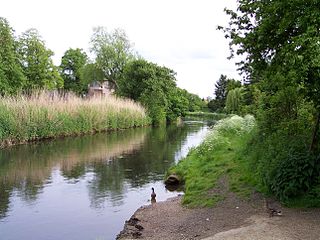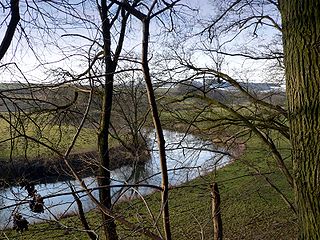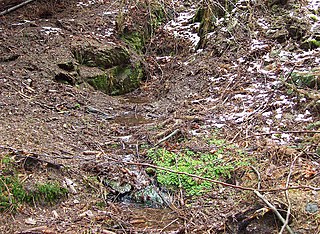
The Ems is a river in northwestern Germany. It runs through the states of North Rhine-Westphalia and Lower Saxony, and discharges into the Dollart Bay which is part of the Wadden Sea. Its total length is 362.4 kilometres (225.2 mi). The state border between the Lower Saxon area of East Friesland (Germany) and the province of Groningen (Netherlands), whose exact course was the subject of a border dispute between Germany and the Netherlands, runs through the Ems estuary.

The Sieg is a river in North Rhine-Westphalia and Rhineland-Palatinate, Germany. It is a right tributary of the Rhine.

The Erft is a river in North Rhine-Westphalia, Germany. It flows through the foothills of the Eifel, and joins the Lower Rhine. Its origin is near Nettersheim, and its mouth in Neuss-Grimlinghausen south of the Josef Cardinal Frings Bridge. The river is 106.6 kilometres (66.2 mi) long, which is significantly shorter than it was originally. Due to the open-pit mining of lignite in the Hambacher Loch, the flow of the river had to be changed.

The Vechte (in German and in Low Saxon or Vecht, often called Overijsselse Vecht in the Netherlands to avoid confusion with its Utrecht counterpart, is a river in Germany and the Netherlands. Its total length is 182 km, of which 107 km are on German soil.
The Aabach is a 14-kilometre-long (8.7 mi) river in Germany, a left tributary of the river Afte. It rises near the village Madfeld, part of the town Brilon, in eastern North Rhine-Westphalia near the border with Hesse. From there it flows north between mountains up to 503 metres (1,650 ft) high through a forested landscape, partly in the natural park Diemelsee. After a few kilometers it flows into the artificial lake Aabachstausee. It flows to the north and empties only about 3.5 kilometres (2.2 mi) further north after Bad Wünnenberg, where it flows into the Afte.

The Niers is a river in Germany and The Netherlands, a right tributary of the river Maas (Meuse). Its wellspring is near Erkelenz, south of Mönchengladbach, in North Rhine-Westphalia (Germany).

The Schwalm (German) or Swalm (Dutch), is a small river in Germany and the Netherlands, tributary to the river Meuse. Its source is near Wegberg, in the district Heinsberg, south-west of Mönchengladbach, in North Rhine-Westphalia (Germany). The Schwalm flows through Wegberg and Brüggen before flowing into the Meuse across the border with the Netherlands, in Swalmen. Its total length is 45 km.

The Vesdre or Weser and Vesder is a river in Liège Province, eastern Belgium. A few kilometres of the upper reaches also flow through the German municipality Roetgen and form part of the Belgian–German border. The Vesdre's total length is approximately 64 kilometres (40 mi). It is a right tributary to the river Ourthe. Its source lies in the High Fens, close to the border with Germany near Monschau. It flows through an artificial lake, and then through the towns of Eupen, Verviers, Pepinster and Chaudfontaine. The Vesdre flows into the Ourthe a few kilometres from Liège where the Ourthe in turn flows into the river Meuse.

The Heller is a 30 km long river in western Germany. It is a left tributary of the Sieg. The source is located near Haiger in Hesse. It flows through Burbach and Neunkirchen in North Rhine-Westphalia. It flows into the river Sieg in Betzdorf, Rhineland-Palatinate. Its basin area is 204 km².

The Düssel is a small right tributary of the river Rhine in North Rhine Westphalia, Germany. Its source is east of Wülfrath. It flows westward through the Neander Valley where the fossils of the first Neanderthal man were found in August 1856. At Düsseldorf it forms a river delta by splitting into four streams, which all join the Rhine after a few kilometres. The Nördliche Düssel flows through the Hofgarten and passes under the Golden Bridge.

The Wurm is a river in the state of North Rhine-Westphalia in western Germany. It rises in the Eifel mountains and flows for 57 kilometres before discharging into the Rur.

The Kyll, noted by the Roman poet Ausonius as Celbis, is a 128-kilometre-long (80 mi) river in western Germany, left tributary of the Moselle. It rises in the Eifel mountains, near the border with Belgium and flows generally south through the towns Stadtkyll, Gerolstein, Kyllburg and east of Bitburg. It flows into the Moselle in Ehrang, a suburb of Trier.

The Agger is a river in Germany, a right tributary of the Sieg in North Rhine-Westphalia. It is 69.5 kilometres (43.2 mi) long. Its source is in the Sauerland hills, near Meinerzhagen. It winds through the towns Engelskirchen, Overath and Lohmar. Near Siegburg the Agger flows into the Sieg.

Schwalmtal is a municipality in the district of Viersen, in North Rhine-Westphalia, Germany. It is named after the river Schwalm, which flows through the area. Schwalmtal is situated approximately 12 km west of Mönchengladbach.

The Werre is a river in the Detmold region (Regierungsbezirk) of North Rhine-Westphalia, Germany, left tributary of the Weser. Its source is near Horn-Bad Meinberg. The Werre flows generally north through the towns Detmold, Lage, Bad Salzuflen, Herford and Löhne. It flows into the Weser close to Bad Oeynhausen. The total length of the Werre is 71.9 km. It crosses the districts of Lippe, Herford and Minden-Lübbecke.

The Diemel is a river in Hesse and North Rhine-Westphalia, Germany. It is a left tributary of the Weser.

Itter is a river of Hesse and of North Rhine-Westphalia, Germany. It is a left tributary of the Diemel. It flows through Willingen.

Bocholter Aa is a river of North Rhine-Westphalia, Germany, and the Achterhoek of the Netherlands. It flows through the town Bocholt. Its last part, before joining the Oude IJssel in Ulft, is called Aa-strang in Dutch.

Ferndorfbach is a river of North Rhine-Westphalia, Germany. It flows through Kreuztal and joins the Sieg in Siegen-Weidenau. Its name relates to the village of Ferndorf, the oldest medieval part of Kreuztal town.

Wenne is a river of North Rhine-Westphalia, Germany. The river springs in a forest area near Obringhausen.





















